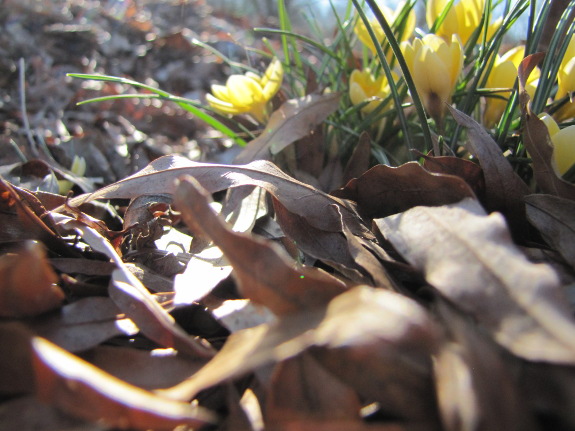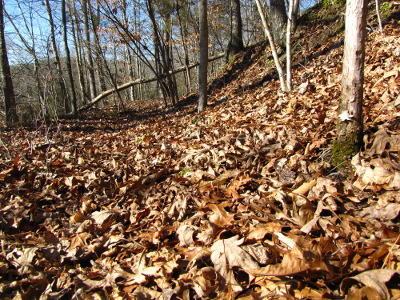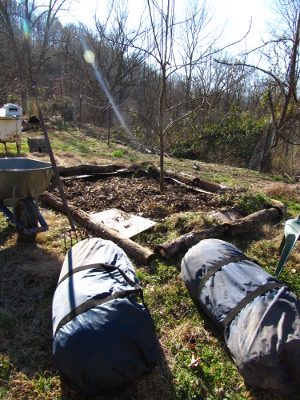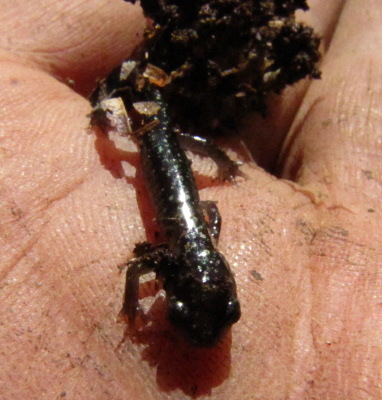
How to gather leaves for mulch

One of the best things
about leaves as mulch is that they're totally free. If you live
in town and pay attention, you can probably snag bags of leaves off the
curb on trash day during the fall. But if you're a rural dweller
like me, you'll want to head into the woods to find your mulch.
 One of the primary
purposes of mulch in the garden is to prevent weeds from growing, so
it's essential that you rake leaves from weed-free areas. Mature
forests (or yard trees over manicured lawns) are your best bet --- our
younger forest areas are home to the invasive Japanese stilt grass, which I
don't want to introduce into my garden.
One of the primary
purposes of mulch in the garden is to prevent weeds from growing, so
it's essential that you rake leaves from weed-free areas. Mature
forests (or yard trees over manicured lawns) are your best bet --- our
younger forest areas are home to the invasive Japanese stilt grass, which I
don't want to introduce into my garden.
Look for dips in the
landscape and areas without a lot of understory growth for easiest leaf
harvests. The old logging road shown here tends to accumulate
leaves drifting down the hill, making it easy for me to scoop them up.
If you're able to drive
right to your leaf-gathering location, you'll probably choose to use a  leaf rake and some sort of
bin to gather leaves. But if you're walking off the beaten path,
I've found it easiest to simply scoop leaves with my hands into large
duffel bags, compacting the leaves frequently so you get the most
leaves per trip. To save your back, gather leaves during dry
weather. (Wet
leaves are heavy.)
leaf rake and some sort of
bin to gather leaves. But if you're walking off the beaten path,
I've found it easiest to simply scoop leaves with my hands into large
duffel bags, compacting the leaves frequently so you get the most
leaves per trip. To save your back, gather leaves during dry
weather. (Wet
leaves are heavy.)

The partially decomposed
duff beneath this year's leaves might be worth harvesting too, as long
as you don't mind creating a slight erosion potential in the spot where
you stole the leaves. Duff is heavier than undecomposed leaves,
which means it's less likely to blow away in the garden, and it is
often full of beneficial mycorrhizae which will boost the growth of
your garden plants. However, if you delve into the duff, try to
pay attention and don't harm the critters living there --- I moved this
tiny salamander to the side with a handful of humus and covered him
back over so he wouldn't dry out.
More in a later post
about the best ways to use leaf mulch in the garden. Meanwhile,
what tips would you add about leaf harvest?
Want more in-depth information? Browse through our books.
Or explore more posts by date or by subject.
About us: Anna Hess and Mark Hamilton spent over a decade living self-sufficiently in the mountains of Virginia before moving north to start over from scratch in the foothills of Ohio. They've experimented with permaculture, no-till gardening, trailersteading, home-based microbusinesses and much more, writing about their adventures in both blogs and books.
Want to be notified when new comments are posted on this page? Click on the RSS button after you add a comment to subscribe to the comment feed, or simply check the box beside "email replies to me" while writing your comment.

When collecting leaves in the city I try to go for the clear bags so I can see the contents because sometimes people stick trash in with their leaves too. Mowed and mulched leaves as well as pine needles bagged and on the curb are a big bonus find for me. Also I've noticed that leaves that are left all winter and then bagged in the spring before people begin mowing usually are already somewhat broken down, but are also usually wet and heavy.
I spent a little time weeding this weekend and realized I'd rather just mulch everything instead.
Frontyard after mulching http://www.flickr.com/photos/20378685@N00/6830715091/in/photostream
Backyard after mulching http://www.flickr.com/photos/20378685@N00/6830729499/in/photostream
Looking at the pictures it looks like I still need to weed the rock path.
Brian --- I know what you mean about mulching instead of weeding. I figure an hour mulching at this time of year saves me about three to five hours of weeding in the summer (when I'm busier.) Plus, it's just more fun.
By the way, your mulched beds look beautiful!
Jeff --- Yup, I was assuming it was a Slimy, even though it didn't slime me. They're our most common salamander (although we also have one that has a similar coloration pattern and is possibly more likely due to the dry habitat where I found this guy --- the Ridge and Valley Salamander.) It's hard to do much ID when they're so tiny (and ready to scurry away.)
One tool I use in gathering leaves in the woods is a tarp. I lay the tarp flat, rake the good pile of leaves onto the middle of my tarp, fold the corners in, and carry it out, Santa style. I have also seen people make a burrito style pack: fold opposite corners in to the middle and tie them, then roll it up the other corners. Finally they tie ropes around it like your duffel bags. They can either carry it or put it on their backs. (but the ropes look like they dig in something fierce.) I like your duffel bags. Strong and big.
Funnily enough, I was just considering the value of leaves as a mulch today. I've been clearing out the copious leaf cover in many areas of my property, and I noticed all the dead spots beneath them. This seems like a good alternative to other methods of sod removal, and I think I'll be trying it on some spots I want cleared next year.
The other great thing about leaves is that you can run them through a small wood chipper once you're done with them, and they then make a great addition to a compost heap.